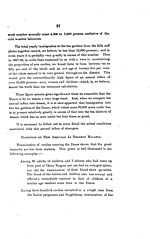Medicine - Disease > Malaria in the Duars
(46) Page 38
Download files
Individual page:
Thumbnail gallery: Grid view | List view

38
young children between the ages of 2 and 9 years yielded
the following results -
per cent.
(1) Children, old residents { 18 with enlarged spleen } 86
3 with no enlargement
(2) Children resident in the 2 with enlarged spleen. 67
Duars 3 months. 1 without enlarged spleen
(3) Children resident only 7 with enlarged spleen 47
2 months. 8 without enlarged spleen
(4) Children resident only 5 with enlagred spleen 33
one month. 0 without enlarged spleen
(5) Children day of arrival 0 with enlarged spleen 0
11 without enlarged spleen
In a small line of hota Nagpuri coolies, 25 children were
examined and 16 were found to have enlarged spleens, while
9 showed no enlargement. Enquiry showed that every
one of the latter were recent arrivals from their country.
Out of another large batch of new children, 29 in num-
ber, who had come with their parents from Ch\ill\ibassa less
than a month previously, only 2 had splenic enlargement.
Among 46 others, resident about 3 months; 22 showed en-
larged spleen, while 24 new children, resident 5 or 6 months,
every one showed splenic enlargement.
Of 9 coolies from Chota Nagpur up a few days, 2 showed slight
enlarged spleen. Of 29 coolies from Kuru (Ranchi) only 2
showed enlargement of the spleen. But among 15 coolies
from the same district up one to two months 8 showed
splenic enlargement; and among 369 adult natives examin-
ed in the Duars without reference to their length of resi-
dence, 257 showed splenic enlargement.
These figures indicate that to the vast majority of immigrants en-
tering the Duars the conditions there present as regards malaria are
quite new and totally different to what they have been accustomed to
in their own homes.
Occasionally, however, a batch of coolies may show the presence of
a good deal of malaria, having evidently come from some locality or
community where malaria was very prevalent. For example:-
Among 12 coolies from Lahardugga, workers in ironstone excava-
tions in the hills, 11 showed enlargement of the spleen when
seen on the day of their arrival in the Duars.
young children between the ages of 2 and 9 years yielded
the following results -
per cent.
(1) Children, old residents { 18 with enlarged spleen } 86
3 with no enlargement
(2) Children resident in the 2 with enlarged spleen. 67
Duars 3 months. 1 without enlarged spleen
(3) Children resident only 7 with enlarged spleen 47
2 months. 8 without enlarged spleen
(4) Children resident only 5 with enlagred spleen 33
one month. 0 without enlarged spleen
(5) Children day of arrival 0 with enlarged spleen 0
11 without enlarged spleen
In a small line of hota Nagpuri coolies, 25 children were
examined and 16 were found to have enlarged spleens, while
9 showed no enlargement. Enquiry showed that every
one of the latter were recent arrivals from their country.
Out of another large batch of new children, 29 in num-
ber, who had come with their parents from Ch\ill\ibassa less
than a month previously, only 2 had splenic enlargement.
Among 46 others, resident about 3 months; 22 showed en-
larged spleen, while 24 new children, resident 5 or 6 months,
every one showed splenic enlargement.
Of 9 coolies from Chota Nagpur up a few days, 2 showed slight
enlarged spleen. Of 29 coolies from Kuru (Ranchi) only 2
showed enlargement of the spleen. But among 15 coolies
from the same district up one to two months 8 showed
splenic enlargement; and among 369 adult natives examin-
ed in the Duars without reference to their length of resi-
dence, 257 showed splenic enlargement.
These figures indicate that to the vast majority of immigrants en-
tering the Duars the conditions there present as regards malaria are
quite new and totally different to what they have been accustomed to
in their own homes.
Occasionally, however, a batch of coolies may show the presence of
a good deal of malaria, having evidently come from some locality or
community where malaria was very prevalent. For example:-
Among 12 coolies from Lahardugga, workers in ironstone excava-
tions in the hills, 11 showed enlargement of the spleen when
seen on the day of their arrival in the Duars.
Set display mode to: Large image | Zoom image | Transcription
Images and transcriptions on this page, including medium image downloads, may be used under the Creative Commons Attribution 4.0 International Licence unless otherwise stated. ![]()
| India Papers > Medicine - Disease > Malaria in the Duars > (46) Page 38 |
|---|
| Permanent URL | https://digital.nls.uk/74558702 |
|---|




